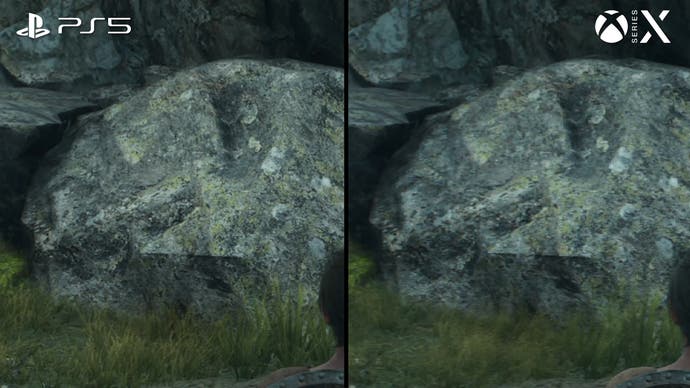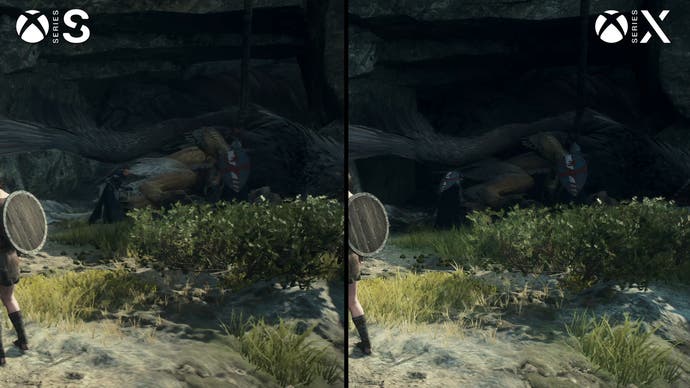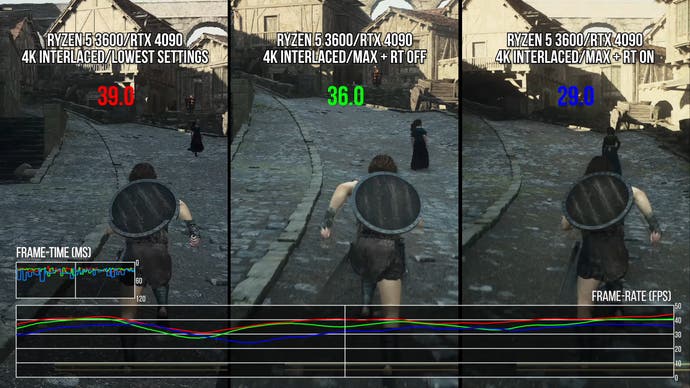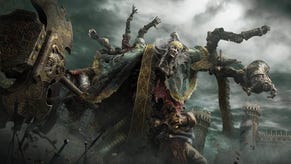Dragon's Dogma 2: a brilliant game in need of technical improvements
All consoles and PC put through their paces.
Dragon's Dogma 2 is a highly anticipated open-world RPG and the most advanced RE Engine title we've seen to date. Beyond the excellent gameplay and concept, this game undeniably looks good, combining high-detail assets with beautiful lighting, but performance concerns are also widespread amongst reviewers and users alike. With that in mind, how have graphics and performance been balanced in the final release? What compromises does the Series S bear against Series X and PS5, and what about PC performance and visual quality?
Dragon's Dogma 2 opens with something unconventionally compelling: an in-depth character creator that provides a lot of flexibility to tweak our Arisen and create something unique. The rendering of the character is impressive, even though high-fidelity facial rendering isn't exactly a key part of the game. Juggling through various presets and options for a few minutes doesn't reveal anything particularly uncanny or off-putting, which is a good accomplishment for this kind of player-driven character editor.
After a short introductory sequence, users enter the game's open-world setting proper, which is quite stunning at times. The standout technology here is the game's use of ray-traced global illumination (RTGI), which makes the environmental lighting look consistently high quality across a range of conditions. There's beautiful subtle occlusion in the intersections of rock faces, diffuse shading from tree branches, and fine shadow falloff around the mouths of caves. In these indirectly lit areas - which are already depicting areas of the world that are draped in shadow - there's a fine impression of how light is subtly occluded by surrounding geometry.
This effect is most striking in the game's major town areas, where buildings look outstanding under this lighting. When looking at the undersides of wood-braced floors or bridges, or the crevices between buildings, the game looks very realistic - light bounces off stonework and wood, softly illuminating adjacent areas in a refined, consistent and natural way. The colour contribution from the sky is also quite evident, especially as dusk and dawn approach.
Some smaller-scale details don't hold up quite as well, with some faintly glowing objects in interiors and sometimes muted secondary lighting as well. Outdoors though, the results are pretty great and at typical viewing distances, we couldn't spot any RT noise or image breakup, aside from the lighting characteristics changing slightly as you near objects.
The game takes some interesting approaches to lighting that we don't necessarily see in a lot of other games. Like the original, night is almost pitch-black, with the player character relying on lanterns to make out anything at all. This is true to the way light behaves in real life, absent a full moon or artificial illumination, and can make night-time excursions particularly suspenseful.

Times of day also transition extremely quickly, which is seen in other titles, like the Horizon games. Here, the game seems to suddenly transition between roughly four states: night, dawn, day and dusk, with slower lighting travel in-between. There's no need to transition between GI bakes, so this might be an artistic flourish or simply a concession to avoid the artefacts that can become obvious with steeply-angled shadowmaps. Those shadowmaps look perfectly fine but do often showcase shadow aliasing and the expected lack of fall-off at a distance. There are some distracting cascade levels as well when the game tries to resolve fine shadow detail, with more distant cascades revealing low-res and slow-moving shadow artefacts.
Screen-space reflections (SSR) are also in use, combined with a cubemap fallback, which can work well or somewhat poor depending on the camera angle and occluding geometry. Similar to other RE Engine titles, there's very pronounced SSR artefacts when characters get in front of SSR detail, but it's less impactful here because the camera is a little more zoomed out. In terms of water, the normal-mapped surface ripples seem to update at an uneven rate, which is a little distracting.
Outside of those lighting details, the world looks appealing. There's a lot of foliage packed into the surroundings when traversing the open world, and the environmental density is satisfying. You can still spot the occasional straight edge here and there, but the assets generally impress. And the game still manages to fit into a svelte sub-70GB package on the consoles, which is likely a lot smaller thanks of the aforementioned RTGI, where real-time calculated lighting offers a much lower footprint than pre-baked assets.
The only major graphical gripe is that some of the game's uninteractive sequences, especially the dialogue sequences, aren't up to the standard that a lot of players might expect. These scenes don't have the most flattering framing or direction, and the facial animation and lip-sync is quite basic. This may or may not be a big issue from your own perspective, and Dragon's Dogma 2 is decidedly a more nonlinear, less story-focused experience than other titles.
In visual settings, the PS5 and Series X are matched with each other, with similar shadow resolution, draw distances and texturing (time of day differences can suggest otherwise, but we're fairly confident about platform parity here). Both machines also use a checkerboard rendering technique, which is a familiar choice for RE Engine titles. Unfortunately though, the image resolve on Series X appears to be broken as of the launch build, with the visuals completely obscured by a fine grid of checkerboarding artefacts. It's a really disappointing issue and it should be resolved soon. RE Engine titles do seem to have recurrent challenges with checkerboarding on consoles - and it never seems to work properly on PC - so this isn't totally unexpected, but it's quite bad in this instance.
Producing an actual pixel count proved unusually difficult, as the game's motion blur can't be disabled - making it hard to find raw edges - and Series X is virtually uncountable as a result of its image quality issues. On PS5 it looks like the game runs at a checkerboarded 4K, and it's likely this is replicated on Series X. The PS5 at least has decent enough image quality, and it does a largely competent job of resolving a crisp image. Foliage does pose a bit of a concern though, as it tends to have considerable artefacting in motion.

To put it bluntly, performance is not good either and needs work. Both PS5 and Series X have an unlocked frame-rate here, with performance that generally lies between 30fps and 45fps. That makes for a stuttering and inconsistent output in general play, no matter what you are doing at any given time. There really should be a 30fps cap in place, if not as the default then at least as an option. The game's central city area is more CPU-limited and performance drops further, with average frame-rates in the 20s (similarly low frame-rates can also be reached in open world combat encounters, though this tends to be only fleeting.) Capcom is taking some considerable steps to reduce CPU load here, like limiting NPC draw to a comically short distance from the player, but it still isn't enough to produce a decent frame-rate and Capcom should address this.
Comparing the two consoles side-by-side for a moment, the Series X scores roughly a 10 percent or a circa-4fps performance win over the PS5 in matching shots. This isn't totally like-for-like because of the Series X's issues with resolving a proper checkerboarded image, but this does seem to be a pretty straightforward Series X win when GPU-limited. When-CPU limited the results are a little more ambiguous, with the PS5 seeming to take a performance win while performing the same run around the city. The one saving grace is that Series X has VRR support with low frame-rate compensation at 120Hz. That makes the game look smoother, relatively speaking, but city areas are again subpar with plenty of frame-variance that isn't tamed by the variable refresh rate - and PS5 doesn't support LFC at all, so its VRR is of more limited use.
The Xbox Series S version of Dragon's Dogma 2 isn't really a close match for the other console versions of the game as RTGI is stripped out, downgrading the visuals significantly. Series S does at least have ambient occlusion and some kind of non-RT global illumination, but it feels more like a last-gen experience on Microsoft's smaller console. Other cuts are also problematic, with reductions to shadow resolution resulting in distracting flicker and artefacting.

We also spotted a texture bug where key high-res textures failed to load in, requiring a restart to fix, though outside of this the game looked reasonably detailed in terms of textures. The Series S version also suffers from the same checkerboarding issue we saw on Series X, so while the resolution is obviously lower, we can't offer a firm pixel count. Performance is also generally similar, with an unlocked frame-rate and plenty of frame-time spikes in populated areas, so the various visual cutbacks haven't produced a better-running game - they've just roughly kept pace.
Given the performance and technical qualities on console, we're looking at a profoundly heavy game in some unexpected ways - and that's reflected in the PC version too. Before we get into how the game performs overall, it's worth covering the initial experience of the game, which includes a shader pre-compilation step which took around two-and-a-half minutes on a Ryzen 7 7800X3D and would take longer on smaller CPUs. This time is well spent, as we didn't encounter any obvious shader compilation stutter - though the game isn't stutter-free.
We spotted two largely inexplicable frame-time spikes above 150ms in the opening chapter on the Ryzen 7 7800X3D, as well as traversal stutter when crossing invisible boundaries in the game world - something we have experienced in other RE Engine titles. On a 7800X3D, these spikes were only 33ms or 50ms, but slower processors will see larger and more frequent spikes. On a technical level though, this frame-time variance is at least less pronounced than in prior RE Engine games.

Menu navigation, unfortunately, doesn't seem to have been designed with mouse and keyboard in mind. One bizarre example is that when you first open the options menu, you can't click on any of the plainly visible sub-options without first clicking on their category - so why have those sub-options visible at all in the first place? There are other menu-based annoyances on PC, but let's move onto performance.
First, the good news: performance is quite good in less populated areas where you'll spend a lot of your time. There's also DLSS and FSR2 upscaling, with frame generation to come. The bad news is that in settlements you'll notice performance dips and frame-times become increasingly erratic, as the game needs to contend with more NPCs and other objects close to the player. This causes the game to become heavily CPU-limited; even on a high-end Ryzen 7 7800X3D, there are spikes up to 50ms and generally uneven frame delivery as the processor ramps up and down - it's possible that CPU utilisation could be improved in future to make performance more consistent on this class of CPU.
On a more entry-level CPU, like the Ryzen 5 3600, performance is significantly worse, perhaps even unplayably poor in some areas. Here, performance is nearer 30fps in our ad hoc city benchmark, compared to around 60fps on the 7800X3D - not great when you consider we're running a top-of-the-line RTX 4090 at 4K interlaced with max settings, including ray tracing. For context, running the same sequence on Xbox Series X results in even worse performance, with around a 10 percent lower frame-rate on average than the Ryzen 5 3600 and the same generally erratic frame times, while using settings that are significantly below max on PC. Interestingly, CPU performance scales with resolution, with 4K being 10 percent slower than 1080p even when CPU-limited. This is somewhat uncommon, but we have seen similar results in the past games like Crysis Remastered.


There is some capability to improve performance and specifically to reduce CPU load, but it's quite limited and has negative repercussions for image quality. Disabling RTGI is the main option, which makes for a less realistic image but claws back around 12 percent performance. However, setting all other options to their lowest values only improves frame-rate by another six percent. As turning off RT makes the game look a lot worse, it's hard to call these 'optimised settings'. Hopefully future game patches improve the situation, as right now the game just doesn't provide a great experience on PC once you hit those towns and cities.
So that's the technical side of the game accounted for then - but what about the overall experience? Dragon's Dogma 2 is a game that really tries to immerse you within its world and create an open-ended environment for the player to explore, with a barebones quest log, few waypoints and some time-limited quests. That's going to excite some people and turn others off. The game has certain Soulslike elements as well, like decreasing your available health when you restart from a checkpoint. If that sounds like a challenge you'd like, there's a lot to enjoy here, though the party-driven combat might not be to everyone's liking.
On a technical level though, there's a lot to appreciate here - despite some key areas that could use improvement. The visuals on high-end machines like PC, PS5 and Series X often look brilliant, with beautiful RTGI that hopefully represents what we can expect from the RE Engine in future titles. Series S is less appealing, without RT of any kind and suffering from low-res shadows. Series S and X have totally broken checkerboarding too, with a very messy resolve. All console platforms and PC also suffer from heavily CPU-bound performance in some areas, with consoles also offering an unlocked frame-rate that gives them an unstable feel even at the best of times.
Dragon's Dogma 2 is a great graphical achievement then, but unfortunately it's let down by some configuration issues on the consoles and heavily CPU-bound performance on all platforms. There's a lot to appreciate visually and its gameplay credentials have been rightly lauded, but equally there are clear areas for improvement post-release.










